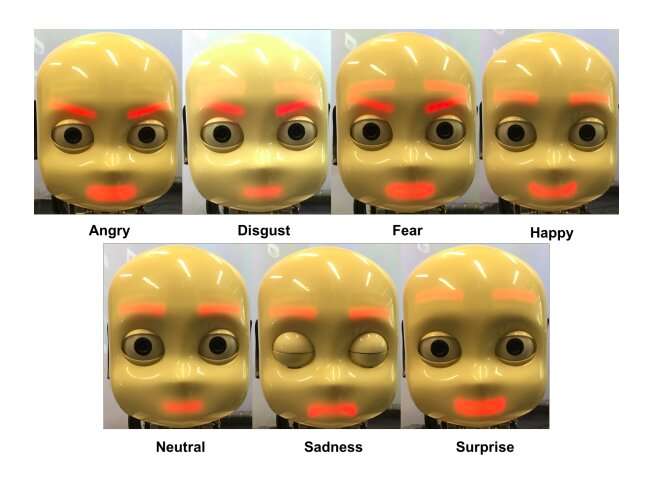April 14, 2020 feature
Teaching the iCub robot to express basic human emotions

As robots make their way into a variety of environments and start interacting with humans on a regular basis, they should be able to communicate with users as effectively as possible. Over the past decade or so, researchers worldwide have thus been developing machine learning-based models and other computational techniques that could enhance human-robot communications.
One way to improve how robots communicate with human users is by training them to express basic emotions, such as sadness, happiness, fear and anger. The ability to express emotions would ultimately allow robots to convey messages more effectively, in ways that are aligned with a given situation.
Researchers at the University of Hamburg in Germany have recently developed a machine learning-based method to teach robots how to convey what have previously been defined as the seven universal emotions, namely anger, disgust, fear, happiness, sadness, surprise and a neutral state. In their paper, pre-published on arXiv, they applied and tested their technique on a humanoid robot called iCub.
The new approach proposed by the researchers draws inspiration from a previously developed framework called TAMER. TAMER is an algorithm that can be used to train multilayer perceptrons (MLPs), a class of artificial neural networks (ANNs).
In the recent study, the TAMER framework was adapted to train a machine learning-based model to convey different human emotions by producing different facial expressions in the iCub robot. iCub is an open-source robotic platform developed by a research team at the Italian Institute of Technology (IIT) as part of the EU project RobotCub, which is often used in robotics research to evaluate machine learning algorithms.
"The robot uses a combination of a convolutional neural network (CNN) and a self-organizing map (SOM) to recognize an emotion and then learns to express the same using an MLP," the researchers wrote in their paper. "Our objective was to teach a robot to respond adequately to a user's perception of emotions and learn how to express different emotions."
The CNN used by the researchers analyzes images of a human user's facial expressions, captured by the iCub robot. The facial feature representations produced by this analysis are then fed to a SOM, which unveils particular patterns in how the user expressed a particular emotion.
Subsequently, these patterns are modeled and used to train an MLP to predict how iCub's facial features can be adapted to best mimic the user's facial expressions. The human user then rewards the robot based on how accurately it expressed a given emotion.
"Once the iCub performs and action, the user is expected to reward it, thus giving it a target value to achieve," the researchers explained in their paper. "This is done by asking the user to mimic the robot, giving it information about how much the action performed differs from the intended action."
Over time, based on the rewards it receives from human users, the framework devised by the researchers should learn to express each of the seven universal emotions. So far, the technique has been evaluated in a series of preliminary experiments using the iCub robotic platform, achieving fairly promising results.
"Although the results were promising and it significantly reduced the time needed for training, our method still required more than 100 interactions per user to learn meaningful expressions," the researchers said. "This number is expected to decrease with improvements in training methodologies and by collecting more data for training."
More information: iCub: Learning emotion expressions using human reward. arXiv:2003.13483 [cs.RO]. arxiv.org/abs/2003.13483
© 2020 Science X Network

















